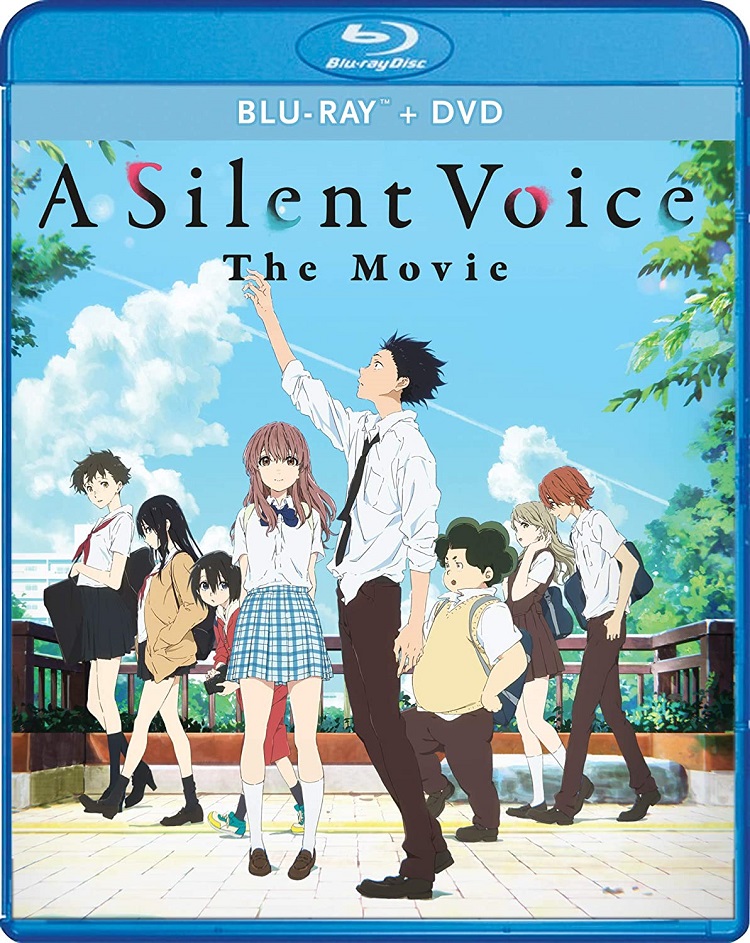
There’s a certain style in Japanese storytelling and film-making where the important things are what is not shown, what is not said, what is not expressed. The subtext between the characters tells the story. Both Uzo and Kore-eda, in very different ways, based most of their careers on putting together stories where the truth beneath the veneer is only revealed by implication and by accident. By a simple gesture. A minor scene.
Animation is a broader art form than live-action film-making, since all the visuals are drawn and, of course, by nature abstracted. There can be nuance, but only up to a point. An animated face is ultimately an oval with a few lines. A lot can be conveyed with this simple configuration, but not everything. A Silent Voice, an anime feature film directed Naoko Yamada and based on a manga by Yoshitoki Oima, attempts this kind of nuanced storytelling, implication and inference, and only succeeds to a degree.
The film opens with the aborted suicide of teenager Shoya Ishida. He’s been planning this for a long time – tying up his lose ends by selling his things, and leaving an envelope of money he owed his mother under her pillow. He is distracted from jumping off the bridge by fireworks, which bring him back to his childhood memories, and the source of all his troubles. Shoya was kind of a big deal in sixth grade – the leader of his pack of friends, the class show-off. The class’ group dynamics are thrown off when a new student is transferred in: Shoko Nishimiya greets the other students by holding up a notebook saying this is how they will communicate, since she is deaf. While there are superficial attempts to integrate the girl into the class society, she ultimately becomes disruptive. The girls begin to ostracize her while Shoya is more directly obnoxious, taking his bullying further and further, with the complicit approval of the entire group. This continues until he goes a step too far, yanking out one of Shoko’s hearing aids too hard, and tearing her ear as he does it.
Suddenly, the kid being ostracized is Shoya, as his complicit friends feign horror at the way he treated the poor girl. This ostracism continues with him all through high school, until he’s a complete social outcast. While most of A Silent Voice is committed to a sort of strict animated naturalism, Shoya’s perspective is stylized – every person he sees has a large blue X over their face. He can’t look anyone in the eye, or talk to anybody. Even when the reasons for his ostracism become forgotten, everyone just knows Shoya is bad news.
So he tries to kill himself, and when that doesn’t work, he decides to go back to the root of his problem: Shoko Nishimiya. In the subsequent years, he’s learned sign language, and has apparently become deeply remorseful about the behavior he’d exhibited. Even when he’s rebuffed, this small step toward connection begins to open Shoya up, and he actually finds a friend in high school. The blue Xs start to fall away. This process of reconnecting with the world begins to blossom in unexpected ways, and Shoya’s feelings toward Shoko might be becoming stronger than just a sense of remorse.
I say maybe, because whatever is actually going on in the hearts and minds of these characters, the film is at pains to keep hidden. Reticence is pretty common in characters in Japanese storytelling, but there are extremes. A Silent Voice, in trying to play its story out subtly, withholds information seemingly at random. For instance, in the first scene we see in Shoya’s home life as a teenager, someone leaves the house, a little dark-skinned little girl says, “Bye, mama!” And Shoya sits to breakfast with his family. In a later scene, he opens a curtain in the room and a dark-skinned man doing weights on the bed smiles at him.
This can be pieced together. Eventually, Shoya introduces the girl as “his sister’s kid”. The man is his sister’s husband. These are small connections, but they are presented in such a way that there seems to be deliberate ambiguity to the characters. Which can be fine, if there’s meaning in it, but there isn’t any here. Once the relationship between Shoya and everyone in his household is clear, there’s no revelation. It’s the withholding of information for its own sake.
The heart of the film involves all of the old friends from elementary school reconnecting, and eventually confronting why Shoko had to be the target of their bullying. There’s an emotional scene where Shoya finally calls out every other childhood bully for their complicity. There are crises, and another suicide attempt. A Silent Voice teeters close to melodrama at times, but it’s a muted melodrama.
A Silent Voice is by no means a bad film – though perhaps too long at 130 minutes, it has some entertaining characters, and explores its situation from a number of angles, though always obliquely. It wants to grab at the heartstrings, but it doesn’t want to seem too eager to do so. For some audiences, this might be the exact right tone that will resonate with them. For me, A Silent Voice was talking to somebody else.
A Silent Voice has been released on Blu-ray and DVD by Shout! Factory. It contains both English and Japanese dialogue with English subtitles. The bonus material includes a pair of music videos related to the film, and a six-minute reel of Japanese trailers and promo videos which are not subtitle in English.